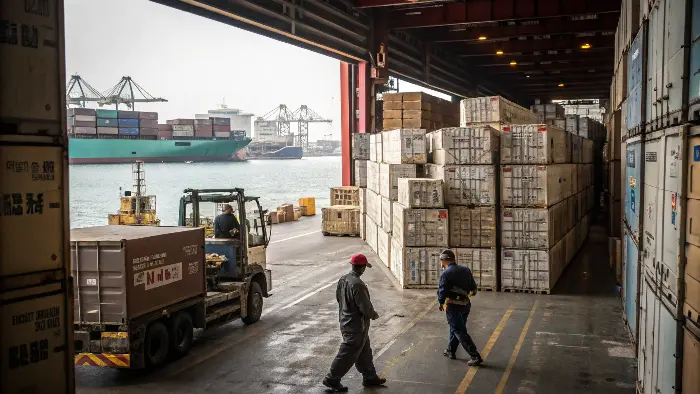Struggling with supply chain nightmares? You’re not alone. These disruptions impact everything, making planning tough. But what if there were ways to smooth out these bumps?
The global stationery supply chain faces significant production and logistics challenges. These include supply chain disruptions, logistics bottlenecks, raw material volatility, fluctuating demand, and geopolitical uncertainties. Addressing these requires diverse suppliers, technology adoption, and robust risk management.
It feels like just yesterday when predicting delivery times was straightforward, right? Now, it’s a whole different ball game. We’ve all felt the pinch, whether it’s unexpected delays or sudden cost spikes. I’ve spent countless hours talking to people like Michael, a product development manager in Germany, and we both agree that understanding these challenges is the first step to conquering them. So, let’s dive into what we’re really up against and, more importantly, how we can start to find some solid ground. Ready to explore this together?
So, What Are the Big Headaches in Global Supply Chains These Days?
Problem: Ever feel like you’re juggling too many flaming torches with global supply chains? Agitation: It’s complex, unpredictable, and one drop can ruin the show. Solution: Understanding these core issues helps us prepare.
Key global supply chain challenges include disruptions from various sources, managing increased complexity and costs, ensuring visibility across the network, and adapting to sudden demand shifts. These make consistent supply difficult.
| I think "headaches" is a pretty good word for it! One of the biggest ones we, at Panoffices, and our clients like Michael, constantly discuss is geopolitical instability. A sudden trade policy change, a new tariff, or regional conflicts can send ripples – no, tidal waves! – through well-laid plans. I remember a specific instance last year when a sudden port lockdown in a key region delayed a whole shipment of our new eco-friendly notebooks. It was a scramble! Then there’s economic volatility. Currency fluctuations can dramatically alter the cost of goods overnight. Imagine agreeing on a price and then, bam, the exchange rate shifts, and your margins are squeezed. It’s not just about getting products from A to B; it’s about doing it predictably and cost-effectively. We also see natural disasters and climate change playing a bigger role. A typhoon in Asia or unexpected weather patterns can shut down production or cripple transport routes for weeks. It’s a stark reminder that we’re interconnected with global events, whether we like it or not. Here’s a quick look at some of these overarching challenges: |
Challenge Category | Specific Examples | Impact on Stationery Supply |
|---|---|---|---|
| Geopolitical | Trade wars, sanctions, regional conflicts | Sourcing restrictions, increased tariffs | |
| Economic | Inflation, currency fluctuations, recessions | Material cost volatility, changed buyer power | |
| Environmental | Natural disasters, extreme weather, resource scarcity | Production delays, transport route closures | |
| Social & Regulatory | Labor shortages, changing compliance laws, pandemics | Manufacturing capacity issues, legal hurdles |
It’s a lot, I know. But being aware is half the battle, right?
When It Comes to Global Logistics, What’s the One Thing That Really Keeps Us on Our Toes?
Problem: Getting your awesome stationery from factory to shelf feels like an Olympic sport sometimes, doesn’t it? Agitation: Delays, damages, and sky-high costs are common hurdles. Solution: Pinpointing the main logistical pain points is key.
A key challenge in global logistics, especially for stationery, is transportation bottlenecks. This includes port congestion, container shortages, unpredictable shipping schedules, and rising freight costs, all impacting delivery reliability.

If I had to pick one thing in global logistics that consistently gives us gray hairs, it’s the unpredictability of transportation. It’s not just one aspect, but a whole bundle of issues. Think about port congestion. We’ve seen ships waiting weeks to unload. For a product manager like Michael, who’s planning a seasonal launch for a back-to-school collection, that’s a nightmare. Those carefully timed promotions? They can go right out the window. Then there’s the infamous container shortage and the subsequent skyrocketing freight costs. I recall a period when the cost to ship a container quadrupled almost overnight! How do you budget for that? It forces some really tough conversations about pricing and sourcing. Beyond the big sea voyages, last-mile delivery also presents unique challenges, especially with diverse stationery items. Some are bulky like organizers, others are delicate like premium pens. Ensuring they all arrive in perfect condition, on time, requires a robust and flexible logistics network. We work hard with our freight forwarders, but honestly, sometimes it feels like we need a crystal ball. It’s this constant dance of planning, re-planning, and communicating with clients to manage expectations. It’s why at Panoffices, we emphasize clear communication and try to build in buffers wherever we can – though sometimes even that isn’t enough!
To break it down further, consider these common logistical snags:
Key Logistical Pain Points:
- Capacity Constraints: Not enough ships, trucks, or air freight available when you need them.
- Infrastructure Limitations: Ports or rail lines that can’t handle peak volumes.
- Information Silos: Lack of real-time tracking and communication between different carriers and stakeholders. This makes proactive problem-solving super difficult.
- Customs & Compliance: Navigating the paperwork and regulations for each country can be a maze. One tiny error can hold up a shipment for days. I’ve seen it happen!
It’s a tough nut to crack, and something we are constantly working to improve.Trying to Set Up a Global Supply Chain From Scratch – What Are the Initial Stumbling Blocks?
Problem: Thinking of sourcing globally for your stationery line? Exciting! Agitation: But where do you even start? It can feel overwhelming with so many unknowns. Solution: Knowing the initial hurdles helps you plan better.
A significant challenge in establishing a global supply chain is identifying and vetting reliable suppliers. This includes ensuring quality standards, ethical practices, production capacity, and effective communication across cultural and language barriers.

| Oh, setting up a global supply chain from scratch! That’s a big undertaking, and I’ve guided many clients through this. The very first, and perhaps biggest, stumbling block is finding and qualifying the right partners. It’s not just about finding a factory that can make your notebooks or pens; it’s about finding one that aligns with your brand’s quality standards, ethical sourcing policies (super important for us at Panoffices and for buyers like Michael in Europe), and can reliably meet your volume and timeline needs. This initial vetting process – factory audits, sample reviews, checking certifications – is intensive. I always tell people, don’t skimp on this part! Another major hurdle is navigating cultural and communication differences. What’s considered a ‘yes’ in one culture might be a ‘maybe’ in another. Building trust and clear communication channels takes time and effort. Then there’s the challenge of understanding and complying with diverse international regulations. Think about product safety standards (like EN71 for toys, which can apply to some kids’ stationery in Europe), import/export duties, and labeling requirements. Each market can be different. For instance, Michael in Germany has very specific compliance needs that we must meet. The initial investment in time and resources can also be daunting. You’re not just paying for products; you’re investing in site visits (or virtual ones, at least), sample development, and potentially legal consultations. It’s a marathon, not a sprint, and patience is definitely a virtue. Here’s a table outlining some of these initial hurdles: |
Establishment Challenge | Description | Why it’s Tricky for Stationery Buyers |
|---|---|---|---|
| Supplier Identification & Vetting | Finding trustworthy manufacturers who meet quality, ethical, and capacity standards. | Time-consuming, requires due diligence, risk of poor quality or scams. | |
| Quality Control Setup | Implementing systems to ensure consistent product quality from a distance. | Hard to monitor remotely, variations can damage brand reputation. | |
| Logistics & Infrastructure | Establishing shipping routes, warehousing, and understanding local logistics in the sourcing country. | Complex, requires expertise, initial costs can be high. | |
| Regulatory Compliance | Adhering to different international trade laws, safety standards, and import/export documentation. | Mistakes lead to delays, fines, or goods being rejected. | |
| Financial & Risk Management | Managing payment terms, currency risks, and establishing contingency plans for disruptions. | Requires financial acumen, exposure to unforeseen costs. |
It really highlights why having an experienced partner like Panoffices, who understands these pitfalls, can be a game-changer. We’ve been through it!
Ever Heard of the 7 C’s of Logistics – Could They Be Our Secret Weapon?
Problem: Logistics can feel like a chaotic puzzle. Agitation: Misunderstandings and errors lead to delays and frustrated customers. What if there was a framework to bring clarity? Solution: The 7 C’s offer a structured approach.
The 7 C’s of logistics provide a framework for effective supply chain management. They typically include: Correct product, Correct quantity, Correct condition, Correct place, Correct time, Correct customer, and Correct cost.

The "7 C’s of Logistics" – it sounds a bit like a secret code, doesn’t it? But honestly, it’s a fantastic framework that I find myself mentally checking off all the time, especially when working on complex orders for clients like Michael. Think of it as a best-practice checklist to make sure everything flows as smoothly as possible. Let’s break them down from a stationery supplier’s perspective, like ours at Panoffices:
- Correct Product: Sounds obvious, right? But imagine ordering 5,000 blue pens and getting black ones! Or a specific Pantone-matched notebook cover that’s slightly off. This is about precision in specifications and rigorous quality checks.
- Correct Quantity: Too few, and you have stockouts and unhappy customers. Too many, and you’re tying up capital in excess inventory. For a large order of planners, getting this spot on is crucial.
- Correct Condition: This is huge for stationery. No one wants a shipment of beautifully designed journals with dented corners or smudged prints. It’s about proper packaging, careful handling, and ensuring products arrive pristine.
- Correct Place (Destination): Sending a pallet of highlighters to the wrong warehouse or, worse, the wrong country? That’s a costly mistake. Accurate addressing and routing are key.
- Correct Time (Timing): This links back to those transportation nightmares. For seasonal items like Christmas-themed stationery or back-to-school supplies, timing is everything. Late arrivals mean missed sales opportunities.
- Correct Customer: Ensuring the shipment reaches the intended recipient. Seems simple, but in complex B2B chains with multiple intermediaries, it needs attention.
- Correct Cost (Price): Managing all the above while keeping logistics costs within budget. This involves optimizing routes, negotiating rates, and minimizing waste.
It’s not always easy to hit all seven perfectly, especially with global disruptions. But by keeping these C’s in mind, we can proactively identify potential issues. For example, when we’re developing a custom stationery set for Michael, we’re thinking about how the packaging will protect the items (Correct Condition) and how the carton markings will ensure it gets to his warehouse smoothly (Correct Place). It’s about anticipating challenges and building robust processes. It’s a continuous improvement journey, for sure!Conclusion
Navigating global stationery supply chains is complex, but understanding challenges and using frameworks like the 7 C’s helps. Smart strategies can lead to better, more reliable outcomes.

